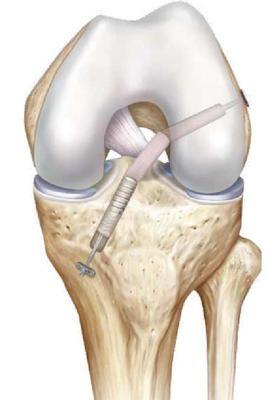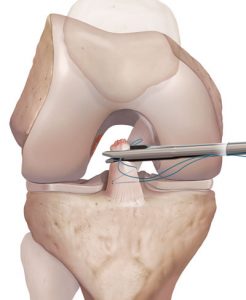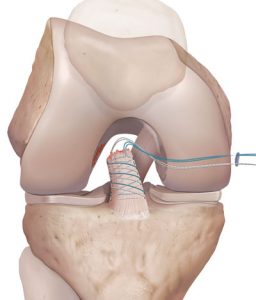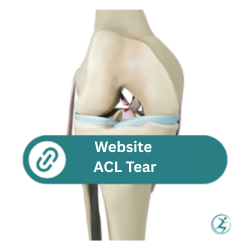ACL specialist in Vienna Dr. Mark Schurz
NEW:
An ACL tear is a serious injury to the knee joint. It is usually a tear of the anterior cruciate ligament. A posterior cruciate ligament tear is rare. The posterior cruciate ligament has a stronger structure and is less easily injured.
The cruciate ligaments are located in the center of the knee joint. They enable correct movement by optimally bracing the upper and lower leg bones to each other.
ACL tear cause
ACL tears often occur in sports with rapid changes of direction, “stop and go” sports, such as soccer, tennis, squash, handball, volleyball, or in sports with high external force and/or speed. The ACL tear occurs particularly frequently when skiing, ice skating or rugby.
What pain occurs with an ACL tear?
In the event of a tear of one or both cruciate ligaments, there is an unnatural mobility of the knee joint, with the tibial head sliding forward uncontrollably. Patients complain of instability, the knee no longer provides support and slips away during movement. This instability occurs immediately after the injury, but is usually only noticed when the leg can be loaded to some extent again.
Persistent “giving way attacks” lead to cartilage and meniscal damage, as the cartilage and menisci are exposed to a significantly higher load. This leads to premature wear with the development of post-traumatic osteoarthritis, which can occur at any age.
A rapid clarification of the injury and an exact diagnosis are of great importance in order to recognize frequent accompanying damage (collateral ligament tear, meniscal pain, cartilage damage) and to be able to treat it immediately.
ACL Tear Diagnosis
The anterior and posterior cruciate ligament tears are determined by clinical tests. Magnetic resonance imaging (MRI) is performed routinely.
The indication for surgical treatment of the cruciate ligament is the clinically determined instability, which, if left untreated, leads to post-traumatic osteoarthritis with meniscal damage.
ACL Tear Healing without Surgery
In principle, it is possible to treat an ACL tear conservatively, but in most cases sufficient stability cannot be achieved by physiotherapy alone. “Giving way attacks” usually continue to occur, which, in addition to pain, lead to recurrent swelling and irreversible damage to the meniscus and cartilage.
In the case of complex knee ligament injuries and in the case of physically active people, surgical treatment by a knee specialist should definitely be carried out.
Surgical Treatment for ACL Tear
ACL Reconstruction all Inside – Method for Children and Adolescents

As an ACL specialist, I rely on the All Inside method for ACL reconstruction – the modern minimally invasive surgical method for ACL tears.
Advances in medical technology have made it possible to improve the technique of ACL reconstruction and make it even more minimally invasive. I use a special drilling and fixation system for this purpose, which creates a maximum of stability and reduces the surgical trauma in knee injuries to an absolute minimum.
What are the advantages of the All-Inside method?
- Removal of only one tendon
- The bone canal is drilled from the inside of the knee joint to the outside, so the sensitive periosteum is only minimally damaged
- Maximum stability
- minimal skin incisions necessary
- ACL tears in adolescents can be operated on in a way that protects the growth plates.
I have already successfully used this minimally invasive technique hundreds of times for knee injuries and am therefore one of the most experienced ACL specialists and knee specialists in Vienna. This technique has only been on the market in Austria for a few years, but it is an already established procedure in the USA.
ACL Reconstruction with Autologous ACL Graft
Tendons located close to the knee joint are used as an autologous ACL graft. Laid four times, they form a stable graft.
The middle third of the patellar tendon (ligamentum patellae) can also be selected to replace a torn ACL. Tendon strips from the quadriceps tendon are also suitable for ACL reconstruction.
Allograft – ACL Reconstruction with Donor Tendon
An allograft is transplanted tissue that comes from a genetically non-identical donor.
This is a body part donation, as has been common for years in the context of heart, liver, kidney, skin or corneal transplants, for example. In contrast to a kidney transplant, no immunosuppressive medication is necessary after the implantation of an ACL allograft. The graft is “washed out” using a special cleaning process, which prevents rejection reactions. The advantage of the donor graft is clearly that no so-called “removal defect” occurs.
The anchoring of the respective graft is carried out with screws, plates or special pins made of titanium or a bioresorbable material.
I discuss the choice of the appropriate graft with each patient individually in order to do justice to the respective injury pattern.
Revision ACL Reconstruction
A revision ACL reconstruction is necessary if an operation to replace the ligament has already been carried out and:
- There is a rerupture of the ACL
- The ACL has not healed
- There is a malposition
- A bore canal widening has occurred
- The ligament was installed too loosely
- The implant has failed
- Anatomical conditions were not taken into account before the operation
Refixation of the Anterior Cruciate Ligament
Two conditions must be met for the reattachment of the anterior cruciate ligament:
- Ideally, the ACL tear should not be older than 4-6 weeks
- The torn ligament should be preserved in its continuity
The decision as to whether a torn ACL can be refixed should be made during the operation. It only makes sense to refix those ACLs that also have a good chance of healing.
Refixation of the ACL – Technique
The knee joint is examined arthroscopically. As a rule, only two small incisions of approx. 3-5mm each are necessary for this. Intraoperatively, the ACL specialist makes the final decision as to whether the ACL can be refixed.
During refixation, the torn ligament is grasped with special forceps and pierced in a loop technique so that the ligament is enclosed to form a strand and thereby regains its original shape. Then, the threads are stably inserted into the bone using two bone thread screw anchors so that the torn ligament has full contact with the bone surface and can grow in.



What should be considered after ACL surgery?
After ACL surgery, the knee should be protected with a special splint (4-point orthosis). The leg should be partially loaded for 6 weeks, with the load being increased according to a specially developed scheme.
After 3 months, an MRI follow-up is performed to visualize the treatment success using imaging. From then on, you can start with building sports. Be sure to follow the instructions of your ACL specialist.
Patient Information
Anterior cruciate ligament replacement surgery
Follow-up treatment Anterior cruciate ligament replacement surgery

Dr. Mark Schurz – ACL Specialist Vienna
CONTACT